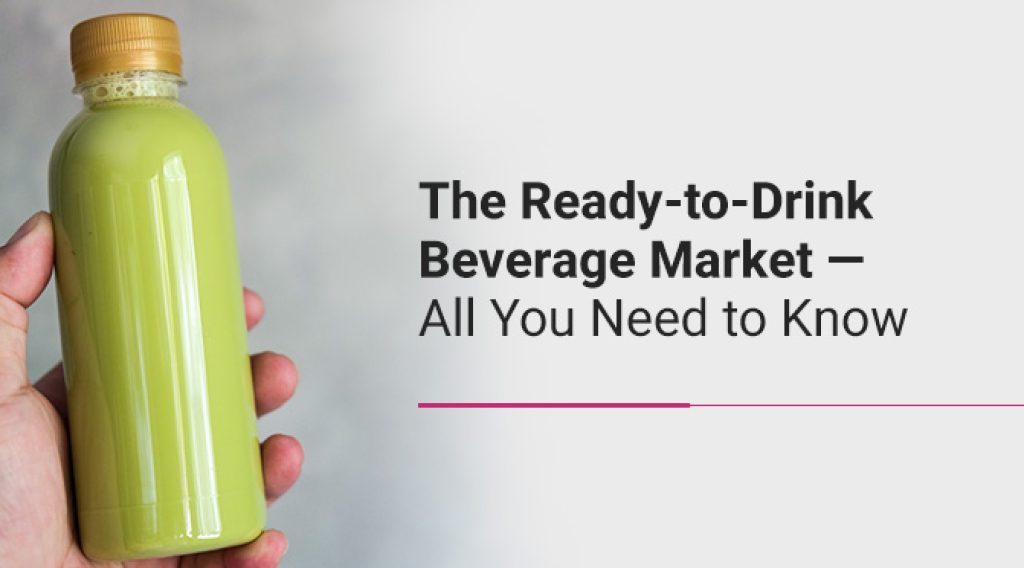The ready-to-drink (RTD) beverage market continues to grow and evolve along with consumer preferences for quick and easy solutions that fit into their busy, active lifestyles. People’s preferences, their desire to stay healthy, marketing strategies and cultural influences all contribute to the growth of this market. Large and small beverage companies are key players in the ready-to-drink category, distributing these drinks globally. The market keeps changing with new flavors, ingredients, packaging formats and consumer demand.
The Current State of the RTD Market
Over the past few years, the ready-to-drink category experienced significant growth, and it shows no sign of slowing down.
In 2021, the worldwide ready-to-drink alcohol market was worth almost $33 billion with premixed, spirits-based RTD suppliers experiencing a remarkable 42% revenue increase between 2020 and 2021. The RTD alcoholic beverages market is soaring and is projected to reach a staggering $1,155 billion in 2030. The RTD cocktail segment specifically will likely experience 11.4% year-over-year growth in 2023.
The RTD market — be it alcoholic or non-alcoholic — is booming with both established giants and fresh ready-to-drink brands jumping in. Major players command their share, but there’s room for innovation and new entrants.
Key Categories and Segments
Alcoholic RTD beverages are typically segmented into three categories:
- Spirits-based RTDs: These are premixed cocktails and seltzers with distilled spirits as the primary alcohol, offering the convenience of premium cocktails in a ready-to-enjoy format.
- Malt-based RTDs: These drinks primarily use a neutral malt base to create approachable, smooth-textured beverages with various flavor profiles, making them a popular choice for easy drinking. These can include hard seltzers and beverages like hard tea and hard kombucha.
- Wine-based RTDs: These beverages feature wine as the alcoholic base, providing a convenient way to savor wine and wine-based cocktails in portable formats, appealing to wine enthusiasts and those seeking wine-infused experiences. Imagine wines in cans and wine cocktails in tetra packs.
The popularity of no- and low-alcoholic RTD beverages has also been steadily rising over the past few years as well. While they still command only a small share of market, they represent a real opportunity for innovation and growth across all three RTD categories.
Non-Alcoholic RTDs include CBD drinks, sparkling waters, teas, coffees and other refreshing alternatives.
Why RTD Beverages Are in Demand
RTD beverages have become a resounding success, driven by a convergence of factors that align with evolving consumer preferences. Here’s a closer look at why RTDs are in high demand.
The 2020 Catalyst
The year 2020 was a pivotal turning point for the RTD beverage market. It accelerated existing trends and prompted a shift in alcohol consumption habits. The onset of the COVID-19 pandemic made staying at home and seeking convenient, enjoyable experiences more important than ever. This influenced the remarkable growth of RTD beverages as consumers embraced the convenience and safety of at-home enjoyment.
Changing Consumer Preferences
As the quest for wellness and healthier choices gains momentum, RTDs have adapted to meet these demands. Today’s consumers seek convenient yet sophisticated options with diverse flavors and premium quality, moving away from sugary and artificial RTDs.
Brands have responded by offering lower-calorie, natural ingredients, aligning with consumer wellness goals. This transformation is rooted in a commitment to consumer satisfaction, making RTDs a choice for premium, sophisticated and health-conscious drinks.
Alcoholic and Non-Alcoholic Options
RTD beverages have blurred category lines, finding success in both the alcoholic and non-alcoholic categories. Alcoholic RTDs have experienced a surge in popularity, with innovations like tequila-based seltzer cocktails, emphasizing authenticity and low-calorie content.
Simultaneously, non-alcoholic RTD beverages have thrived, particularly among Gen Z consumers seeking alternatives to traditional alcoholic drinks. This shift in consumption patterns aligns with the sober curious movement, which encourages consumers to explore alcohol-free options without compromising on taste and quality.
A Versatile Market
The versatility of the RTD market plays a pivotal role in its success. Consumers can now choose from various options, including alcoholic RTD cocktails, canned wines, mocktails and non-alcoholic choices. This variety caters to diverse tastes and preferences, enabling experimentation with new flavors and styles without the need to gather ingredients or mix drinks at home.
Emerging Trends and Key Drivers for Ready-to-Drink Brands
 Convenience, instant gratification and a dedication to quality drive the success of the RTD market. These aspects match what today’s consumers prefer and lead them to choose drinks that fit their busy lives. The RTD beverage market represents a convergence of convenience, innovation and consumer-centric offerings. By understanding these shifts, businesses can adapt and thrive in this changing market landscape.
Convenience, instant gratification and a dedication to quality drive the success of the RTD market. These aspects match what today’s consumers prefer and lead them to choose drinks that fit their busy lives. The RTD beverage market represents a convergence of convenience, innovation and consumer-centric offerings. By understanding these shifts, businesses can adapt and thrive in this changing market landscape.
Innovative Flavor Profiles
Innovation in flavor profiles is a defining characteristic of the RTD beverage market. Ready-to-drink brands are venturing beyond conventional offerings, introducing novel combinations that tantalize taste buds. These special flavors, such as mixed fruits or herbs, attract modern consumers.
Health-Conscious Offerings
With more people caring about their health, the RTD beverage market offers different choices to keep you well. Non-alcoholic offerings incorporate functional ingredients like probiotics, adaptogens and natural sweeteners. Alcoholic RTD products are changing, too, as more low alcohol-by-volume options are available to match the trend of mindful drinking.
Sustainable Packaging
Sustainability is important in the drink industry, and the RTD market is following that, too. Ready-to-drink brands often adopt environmentally friendly packaging solutions, from recyclable cans to compostable materials. People who value being eco-friendly and want products that match their beliefs find this approach appealing.
Direct-to-Consumer (DTC) Channels
Direct-to-consumer (DTC) sales of RTD beverages have seen a sharp increase over the past few years. With consumers embracing online platforms as a convenient way to explore and purchase RTD beverages, many RTD beverage brands have leaned into DTC sales in addition to traditional retail distribution. DTC selling has become not only a source of revenue, but also another channel to reach and connect with their target market.
Hybrid Beverage Experiences
Blurring the lines between categories, hybrid beverage experiences are gaining traction. RTD drinks that combine different types offer consumers exciting and unique flavors. Think wine-based margaritas, tea-based spirits or hard coffees. These innovations tap into consumers’ curiosity and desire for multifaceted flavors, pushing the boundaries of traditional beverage offerings.
Global Exploration and Localization
The ready-to-drink category is growing worldwide and beginning to include local flavors. Brands are crafting region-specific offerings that resonate with cultural nuances. By focusing on regional preferences, brands can connect better with consumers. These connections make people loyal to the brand and help it grow.
Technology-Driven Personalization
Technology is redefining the beverage experience, and the RTD market is no stranger to this trend. Brands are using data-driven insights to personalize recommendations, catering to individual preferences. Technology can help consumers find the right drink, suggesting a cocktail or non-alcoholic choices that fit their diet.
Connect With a Beverage Specialist Today
At MyDrinkBeverages, we provide a wide range of services for beverage development, finding ingredients and making drinks. We help both new businesses and entrepreneurs create drinks. We aim to turn your drink ideas into reality efficiently and successfully, going beyond what you even hoped for. Our team of sourcing experts can see the big results of your choices today. They make sure things work well in the future. Reach out to us to talk about your future strategies.

